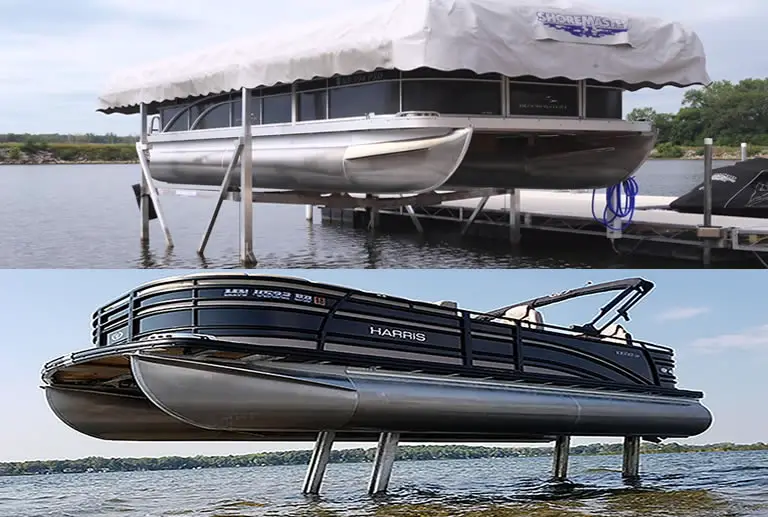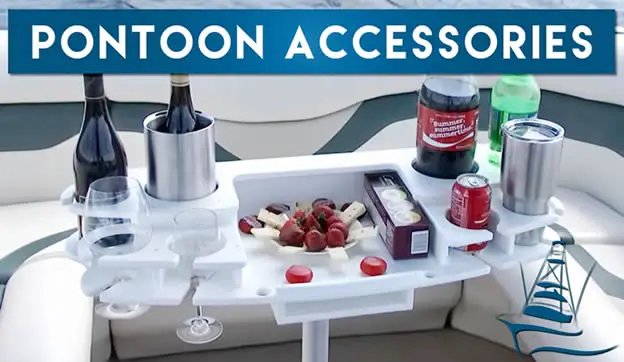A pontoon boat lift serves a very important function for what is a very expensive boat. With high price tags on modern pontoon boats it’s a good idea to pay a little extra for the added protection a pontoon boat lift offers you. But how does a pontoon boat lift protect your boat and how does it work?
A pontoon boat lift is designed to protect your expensive pontoon boat.
A boat lift works by using a simple air or hydraulic system, which is connected to a support structure, to literally lifts the boat out of the water.
Lifting the boat out of the water helps protect it from water damage when not in use and makes maintenance work easier without having to dry dock the boat. Additionally, portable boat lifts can be used to offer more stability and damage protection to a boat in challenging conditions by lifting it out on the water.
Contents
- How boat lifts work
- The 2 most popular types of pontoon boat lift & how they work
- 5 Ways in which a pontoon boat lift is helpful
- 1. A pontoon boat lift offers water absorption protection
- 2. Protection from water level fluctuations is the main reason for using a pontoon boat lift
- 3. A boat will make launching your pontoon boat easier
- 4. A pontoon boat offers easier access to the hull for easier maintenance
- 5. A pontoon boat lift provides stability on the water in challenging conditions
- How a pontoon boat lift is operated
- Understanding if you need a pontoon boat lift
How boat lifts work
There are two types of boat lift that are used for pontoon boats.
A pontoon boat lift will work via one of the following mechanical systems:
- Air/water displacement.
- Hydraulics.
Most modern boat lifts for pontoon boats, both permanent dock lifts and portable lifts, are operated via a hydraulic system.
The older style of pontoon boat lift operates on air and water displacement.
An air/water displacement system is used on older pontoon boat lifts
The air/water displacement pontoon boat lift is the original type of lift.
It works via an electric blower which dispenses air into a set of small pontoons situated in the water which raises the lift situated underneath the boat.
To lower the lift water flow is regulated to push the water flow back into the small pontoons which thus lowers the lift back down and into the water.
These types of boat lifts need only 48″ (4 feet) of water to operate. The lift has a lifting range of about four feet also.
Hydraulics are the modern method for operating a pontoon boat lift
Hydraulics is the modern approach to pontoon boat lifting.
This style of pontoon boat lift uses hydraulic rams. The hydraulic rams are connected to pontoon tubes that are filled with foam.
To raise the lift, and the boat, out of the water the hydraulic rams push the pontoons under the boat to raise it above the waterline. To lower the boat the rams push the pontoons clear of the boat thus allowing the boat to lower onto its own pontoons.
These lifts only require about 12″ of water, plus the pontoon boat’s draft, to operate in. This is because the pontoons float on top of the water, thus requiring very little clearance.
To better understand how both these types of pontoon boat lifts work we need to look at why they are used in the first place.
The 2 most popular types of pontoon boat lift & how they work
As well as there being air/water displacement lifts and hydraulic lifts, there are also 2 different types of pontoon boat lift.
Types of pontoon boat lift:
- Permanent dock lifts.
- Portable lifts called “pontoon boat legs”.
Permanent dock lifts
Dock lifts are permanently placed where you moor your pontoon boat.
Once installed these lifts can’t be moved.
Dock lifts are deigned for the safety and protection of your pontoon boat while it is moored, for all the reasons stated above.
Pontoon lift legs
Pontoon lift legs are currently the only form of portable pontoon boat lift available.
They work on a hydraulic system to lift the pontoon boat out of the water when the boat is in sufficiently shallow water. They are used mostly when no dock space is available.
Be sure your boat is not over its weight limit when you attempt this.
Be sure to also read our article on the 55 best pontoon boat accessories especially if you want to have a pontoon boat party or use your vessel for other fun activities.
5 Ways in which a pontoon boat lift is helpful
There are three basic reason for using a pontoon boat lift.
The reasons for using a pontoon boat lift are:
- Water absorption protection.
- Protection from water level fluctuations.
- Easier launching.
- Easier maintenance.
- Extra stability in troubling conditions
Although each of the above reasons for using a pontoon boat lift are important by far the most important is protecting your boat from water damage.
Let’s look at these 5 reasons for using a pontoon boat lift in more detail.
1. A pontoon boat lift offers water absorption protection
Not all pontoon boat owners take their boats out of the water at the end of a day of boating. Although keeping your boat out on the water may not seem like that much of a big deal, after all fishing boats stay in the water constantly, but over time water can start to erode the expensive exterior of your pontoon boat.
Believe it or not most non-commercial boats spend more time out of the water than in it.
Constant contact with water can have a very detrimental effect on your pontoon boat, leading to hull blisters and wear on the motor and lower unit area. Although bottom paint can be used to protect the bottom of the pontoons, algae can gather up quite quickly and strip away paint and eventually cause damage to the integrity of the pontoons leading to leaks.
Pontoon boats are not cheap. They are some of the most expensive personal vessels on the water. So protecting your boat from water damage is probably a pretty high priority for you, or at least it should be. A pontoon boat lift can help protect the boat from most corrosion problems by simply lifting it out of the water when it is not in use.
2. Protection from water level fluctuations is the main reason for using a pontoon boat lift
Although pontoon boats are usually used on inland waters where water level fluctuations are less pronounced, than they are ocean bays or ocean docks for example, many areas where pontoon boats are used do experience water level fluctuations.
When water levels fluctuate there is always the chance of damage occurring to moored boats.
With the aid of a lift a pontoon boat can be raised above any water level fluctuations that occur thus protecting it from potential damage due to water instability or debris washed in to the docking area.
Fluctuating water levels can also have an impact on your boat when it’s time to use it. It can be awkward, or even hazardous, to try to board or disembark from a pontoon boat when the water level is constantly changing. A floating boat lift can help stabilize the movement of the boat that is caused by the constantly changing water levels thus making it safer to get on and off the boat.
3. A boat will make launching your pontoon boat easier
Permanent dock lifts can also greatly help when launching and docking your pontoon boat.
This can be especially beneficial in choppy water conditions. All you need to do is drive the boat off the lift.
4. A pontoon boat offers easier access to the hull for easier maintenance
A pontoon boat lift also makes it much easier to gain access to the entire hull of the boat for damage checking and maintenance work without having to move the boat onto dry land.
This not only makes maintenance checking easier but it reduces the risk of damage caused by loading the boat and trailering it to a maintenance area. You’d be surprised by how many times damage is done to a boat when moving it to or from a dry dock.
5. A pontoon boat lift provides stability on the water in challenging conditions
A pontoon lift is also a great way to increase stability while out on the water. Though not designed for this use, many pontoon boat owners with use the lift legs attached to their boat (more on these lift legs later) for this very purpose.
When in shallow areas you can simply deploy the lift legs and raise the boat out of the water for instant stability. Obviously doing this in very challenging conditions or rough water is not a good idea but it can stop the boat from rocking in slightly choppy waters.
This type of pontoon boat lift is referred to as pontoon lifting legs. This is a portable type of lift that is attached to the bottom of the pontoon boat and can be engaged while out on the water.
How a pontoon boat lift is operated
A pontoon boat lift is a stable platform that fits underneath the boat.
By the use of hydraulics or air the platform is lifted up to raise the boat out of the water.
Most pontoon boat lifts are operated via a switch control.
Understanding if you need a pontoon boat lift
Do you really need to get a lifting system for your pontoon boat?
Well the answer depends on how you use your pontoon boat and how you store it.
There are different styles of pontoon boat lift used for different purposes. Although every boat lift is designed to raise your pontoon boat out of the water not all lifts are designed to achieve that aim in the same way. So, go for one that suits your needs not just the most popular model.



